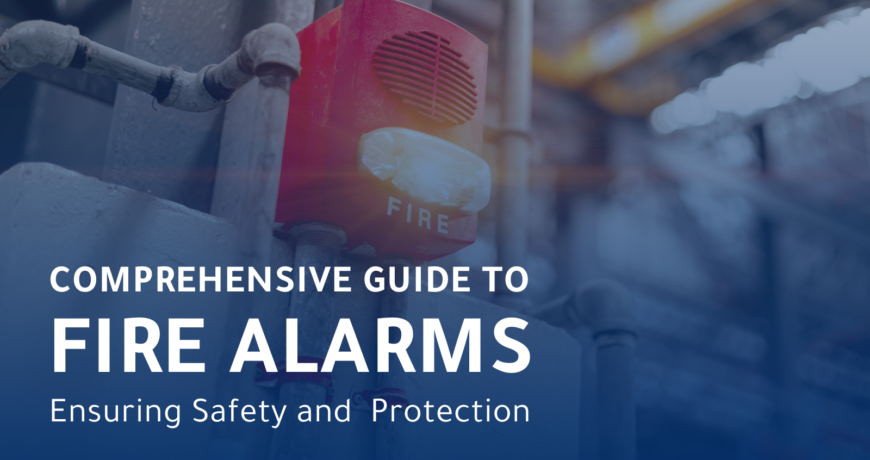Comprehensive Guide to Fire Alarms: Ensuring Safety and Protection
Fire alarms are critical components in safeguarding lives and property from the devastating effects of fire. These systems are designed to detect smoke, heat, or fire and provide early warning, allowing people to evacuate and emergency services to respond promptly. In this guide, we’ll delve into various aspects of fire alarms, exploring their types, how they work, the importance of regular maintenance, and more. Whether you’re a homeowner, business owner, or safety professional, understanding fire alarms is essential to ensuring safety and protection.
How Fire Alarms Work
Fire alarms operate by detecting signs of fire, such as smoke, heat, or flames, and triggering an alert to warn occupants. The system usually comprises several components, including detectors, control panels, and alarm devices. Smoke detectors, for instance, identify particles in the air, while heat detectors sense significant temperature increases. Once a potential fire threat is detected, the control panel processes this information and activates the alarm system, often sounding an audible alarm and flashing lights to signal the danger.
Advanced fire alarm systems may also be integrated with sprinklers, emergency lighting, and remote monitoring, enabling quicker response times and reducing the risk of severe damage. By understanding the basic mechanics of how fire alarms work, individuals can better appreciate the critical role these systems play in fire prevention and protection.
 Types of Fire Alarms
Types of Fire Alarms
Fire alarms come in various types, each suited for different environments and specific needs. The most common types include smoke alarms, heat detectors, and multi-sensor alarms.
– Smoke Alarms: These are the most prevalent type and are typically installed in residential settings. They detect smoke particles and can be further categorized into ionization smoke alarms, which are more responsive to flaming fires, and photoelectric smoke alarms, which are better at detecting smoldering fires.
– Heat Detectors: These alarms are more suited for areas like kitchens or garages, where smoke might be present without an actual fire. They respond to a rise in temperature rather than smoke, making them ideal for environments where smoke detectors might cause false alarms.
– Multi-Sensor Alarms: These combine various detection methods, such as heat and smoke detection, offering a more comprehensive approach to fire detection. They are commonly used in commercial buildings where early detection is crucial.
Each type of fire alarm serves a unique purpose, and selecting the right one for your specific environment is key to ensuring effective protection.
Importance of Regular Maintenance
Regular maintenance of fire alarm systems is vital to ensure they function correctly when needed most. Over time, dust, debris, and environmental factors can affect the performance of detectors and other components. Regular inspections, cleaning, and testing are necessary to keep the system in optimal working condition.
Neglecting maintenance can lead to false alarms or, worse, a failure to detect a real fire. Building codes and insurance requirements often mandate regular checks and professional servicing of fire alarm systems. A well-maintained system not only ensures safety but also complies with legal and insurance obligations, providing peace of mind that your property and occupants are protected.
Fire Alarm Installation Guidelines
Proper installation of fire alarms is crucial to their effectiveness. Placement, type of alarm, and compliance with local codes are all factors that must be considered during installation.
For residential settings, smoke alarms should be installed in every bedroom, outside sleeping areas, and on every level of the home, including the basement. Heat detectors may be installed in kitchens, attics, or garages where smoke alarms might cause false alarms.
In commercial or industrial settings, the installation must adhere to specific guidelines, including the placement of alarms in high-risk areas, integration with other safety systems, and compliance with local fire codes. Professional installation by certified technicians is often required to ensure that the system meets all legal and safety standards.
Choosing the Right Fire Alarm for Your Needs
Selecting the appropriate fire alarm system depends on several factors, including the size and layout of the building, the presence of high-risk areas, and specific safety requirements.
For homeowners, a combination of smoke and heat detectors might provide the best coverage. Multi-sensor alarms can offer enhanced protection, particularly in larger homes or areas with varied risks.
For businesses, especially those in industries with a higher fire risk, such as manufacturing or food processing, a more complex system may be necessary. This might include a combination of smoke, heat, and flame detectors, along with integration with sprinklers and emergency lighting.
Consulting with a fire safety professional can help in making an informed decision, ensuring that the selected system provides comprehensive protection tailored to your specific needs.
Integrating Fire Alarms with Other Safety Systems
Fire alarms are often part of a broader safety system that includes sprinklers, emergency lighting, and even security systems. Integrating these systems can enhance overall safety and streamline emergency response.
For example, a fire alarm system can be linked to automatic sprinklers that activate when a fire is detected, helping to contain the blaze before it spreads. Integration with emergency lighting ensures that exit routes are illuminated during a fire, facilitating safe evacuation.
In commercial settings, fire alarm systems may also be connected to security systems, allowing for remote monitoring and control. This integration ensures a coordinated response in an emergency, minimizing risks and protecting both lives and property.
Fire Alarm Compliance and Legal Requirements
Compliance with local fire codes and regulations is a legal obligation for both residential and commercial property owners. These regulations often dictate specific requirements for fire alarm installation, maintenance, and testing.
Failure to comply with these regulations can result in fines, legal liability, and increased insurance premiums. In some cases, non-compliance may even lead to the suspension of business operations until the required measures are implemented.
Staying informed about the latest fire safety regulations and working with certified professionals to ensure compliance is essential for protecting both your property and its occupants. Regular audits and inspections can help identify any areas where improvements may be needed.
Conclusion
Fire alarms are a vital part of any fire safety strategy, offering early detection and warning that can save lives and reduce property damage. From understanding how these systems work to selecting the right type and ensuring proper installation and maintenance, this comprehensive guide provides the knowledge needed to make informed decisions about fire alarms.
By prioritizing fire safety and staying compliant with regulations, individuals and businesses can create safer environments, reducing the risk of fire-related incidents. Whether you’re protecting a home, business, or industrial facility, investing in a reliable fire alarm system is a crucial step in safeguarding what matters most.






There are no comments